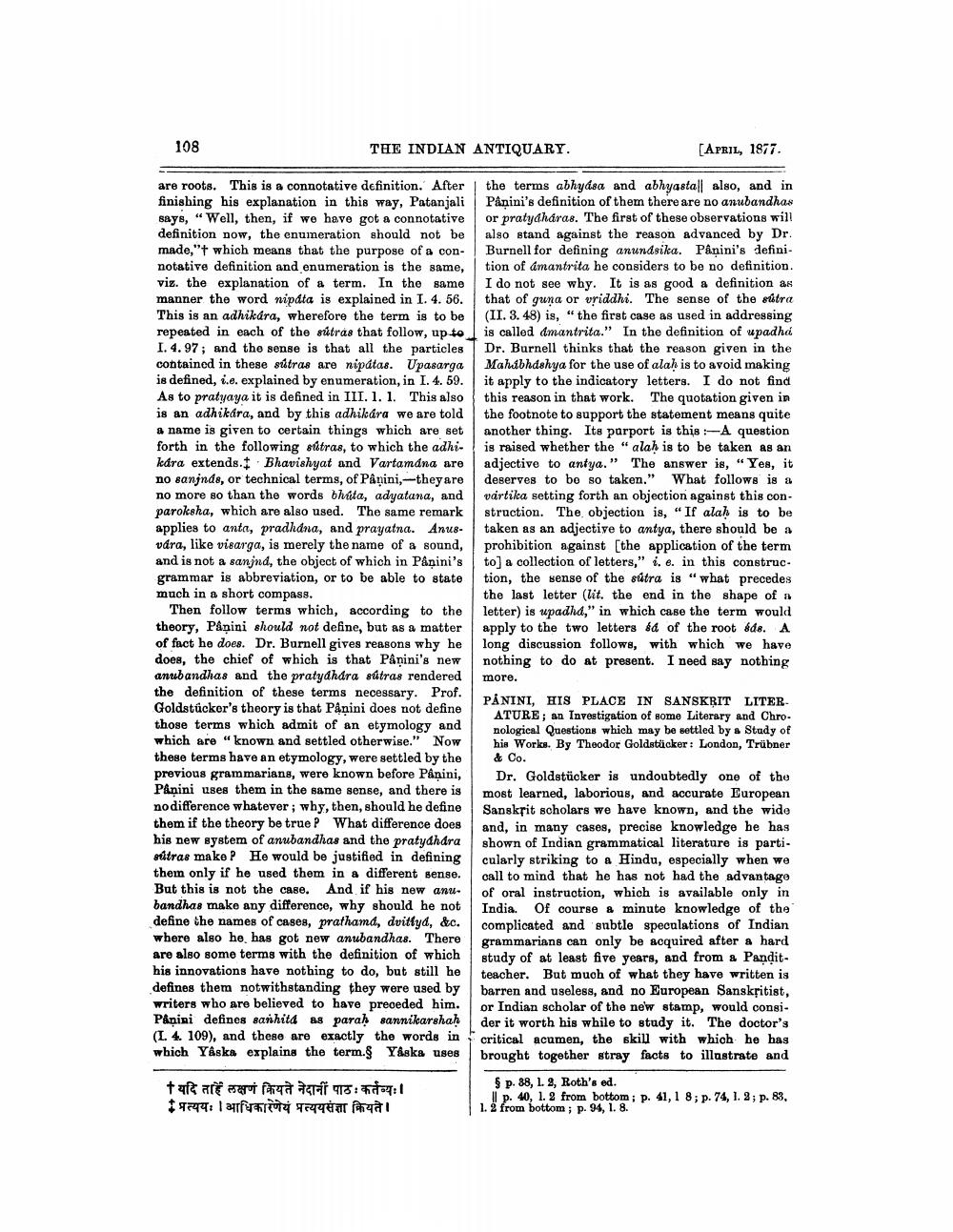________________
108
THE INDIAN ANTIQUARY.
are roots. This is a connotative definition. After finishing his explanation in this way, Patanjali says, "Well, then, if we have got a connotative definition now, the enumeration should not be made," which means that the purpose of a connotative definition and enumeration is the same, viz. the explanation of a term. In the same manner the word nipáta is explained in I. 4. 56. This is an adhikára, wherefore the term is to be repeated in each of the sutras that follow, up to I. 4.97; and the sense is that all the particles contained in these sutras are nipátas. Upasarga is defined, i.e. explained by enumeration, in I. 4. 59. As to pratyaya it is defined in III. 1. 1. This also is an adhikára, and by this adhikára we are told a name is given to certain things which are set forth in the following sutras, to which the adhikára extends. Bhavishyat and Vartamána are no sanjnds, or technical terms, of Pânini,-they are no more so than the words bhita, adyatana, and paroksha, which are also used. The same remark applies to anta, pradhana, and prayatna. Anusvára, like visarga, is merely the name of a sound, and is not a sanjnd, the object of which in Pânini's grammar is abbreviation, or to be able to state much in a short compass.
Then follow terms which, according to the theory, Pânini should not define, but as a matter of fact he does. Dr. Burnell gives reasons why he does, the chief of which is that Panini's new anubandhas and the pratydhára sûtras rendered the definition of these terms necessary. Prof. Goldstücker's theory is that Pânini does not define those terms which admit of an etymology and which are "known and settled otherwise." Now these terms have an etymology, were settled by the previous grammarians, were known before Pânini, Panini uses them in the same sense, and there is no difference whatever; why, then, should he define them if the theory be true? What difference does his new system of anubandhas and the pratyahára sútras make? He would be justified in defining them only if he used them in a different sense. But this is not the case. And if his new anubandhas make any difference, why should he not define the names of cases, prathamá, dvittyd, &c. where also he has got new anubandhas. There are also some terms with the definition of which his innovations have nothing to do, but still he defines them notwithstanding they were used by writers who are believed to have preceded him. Panini defines sanhita as paraḥ sannikarshaḥ (I. 4. 109), and these are exactly the words in which Yâska explains the term.§ Yáska uses
+ यदि ता लक्षणं क्रियते नेदानीं पाठः कर्तव्यः । * प्रत्ययः । आधिकारणेयं प्रत्ययसंज्ञा क्रियते ।
[APRIL, 1877.
the terms abhyasa and abhyastal also, and in Pânini's definition of them there are no anubandhas or pratyaháras. The first of these observations will also stand against the reason advanced by Dr. Burnell for defining anundsika. Pânini's definition of amantrita he considers to be no definition. I do not see why. It is as good a definition as that of guna or vriddhi. The sense of the sutra (II. 3. 48) is, "the first case as used in addressing is called amantrita." In the definition of upadhá Dr. Burnell thinks that the reason given in the Mahabhashya for the use of alaḥ is to avoid making it apply to the indicatory letters. I do not find this reason in that work. The quotation given in the footnote to support the statement means quite another thing. Its purport is this:-A question is raised whether the "alah is to be taken as an adjective to antya." The answer is, "Yes, it deserves to be so taken." What follows is a vartika setting forth an objection against this construction. The objection is, "If alaḥ is to be taken as an adjective to antya, there should be a prohibition against [the application of the term to] a collection of letters," i. e. in this construction, the sense of the sutra is "what precedes the last letter (lit. the end in the shape of a letter) is upadhd," in which case the term would apply to the two letters éd of the root éde. A long discussion follows, with which we have nothing to do at present. I need say nothing
more.
PANINI, HIS PLACE IN SANSKRIT LITERATURE; an Investigation of some Literary and Chronological Questions which may be settled by a Study of his Works. By Theodor Goldstücker: London, Trübner & Co.
Dr. Goldstücker is undoubtedly one of the most learned, laborious, and accurate European Sanskrit scholars we have known, and the wide and, in many cases, precise knowledge he has shown of Indian grammatical literature is particularly striking to a Hindu, especially when we call to mind that he has not had the advantage of oral instruction, which is available only in India. Of course a minute knowledge of the complicated and subtle speculations of Indian grammarians can only be acquired after a hard study of at least five years, and from a Panditteacher. But much of what they have written is barren and useless, and no European Sanskritist, or Indian scholar of the new stamp, would consider it worth his while to study it. The doctor's critical acumen, the skill with which he has brought together stray facts to illustrate and
§ p. 38, 1. 2, Roth's ed.
p. 40, 1. 2 from bottom; p. 41, 1 8; p. 74, 1. 2; p. 83, 1. 2 from bottom; p. 94, 1. 8.




